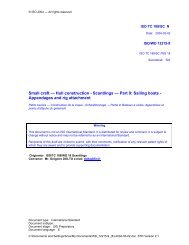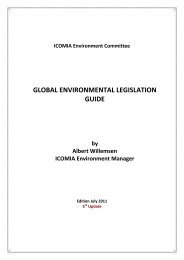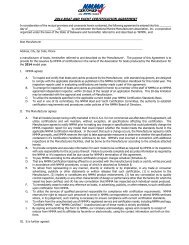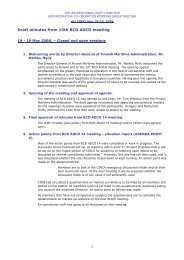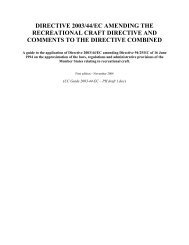Boat Transporters - National Marine Manufacturers Association
Boat Transporters - National Marine Manufacturers Association
Boat Transporters - National Marine Manufacturers Association
Create successful ePaper yourself
Turn your PDF publications into a flip-book with our unique Google optimized e-Paper software.
GOVERNMENT RELATIONSRecommendedBEST PRACTICESFORBOATTRANSPORTERSNMMA Transportation Task Forcenmma.org200 E. Randolph Drive, Suite 5100, Chicago, Illinois 60601–6528, USA Phone 312.946.6200 Fax 312.946.0388
TABLE OF CONTENTSSection1 INTRODUCTION 41.1 Purpose of the Document1.2 AudienceSection2 CONTRACTUAL ISSUES 52.1 U.S. DOT Number2.2 SafeStat Score and MC Number2.3 Safety Requirements2.4 Independent Contractor Status2.5 Hours of Service2.6 Insurance Requirements2.7 SCAC Code2.8 OtherSection3 DEALER PICK-UP CHECKLIST 83.1 Equipment3.2 Driver3.3 DocumentationSection4 CARGO SECUREMENT 94.1 Performance Criteria4.2 Tips for <strong>Boat</strong> <strong>Transporters</strong>Section5 TRANSPORTATION TASK FORCE STAFF 103
INTRODUCTION1.1 Purpose of the DocumentThe <strong>National</strong> <strong>Marine</strong> <strong>Manufacturers</strong> <strong>Association</strong> Transportation Task Force has developed this documentto provide boat manufacturers and professional boat transporters with a clearly defined set of recommendedbest practices. The Task Force developed these best practices after a series of meetings in 2005 and2006. Use of these best practices will help ensure that recreational boat manufacturers transport theirproducts in a safe, prudent and lawful manner, which will further enhance the boat buying experiencefor all parties.These best practices are not intended as legal advice nor do they contain every item that a boat transportershould be aware of prior to hauling a boat. NMMA encourages boat manufacturers and transporters tocontact their attorney for legal advice regarding their specific situation.1.2 AudienceSection1This document is targeted to transportation managers for boat manufacturers, boat transporters and anyother entity involved with the commercial transportation of recreational boats.CONTRACTUAL ISSUESFirst and foremost, a transportation manager should ensure that a written contract be in place with anytransporter detailing the agreement for services and rates to be charged, prior to shipment. The contractshould set forth the duties and obligations of each party. The following items should be addressed in acontract and verified by the transportation manager.2.1 U.S. DOT NumberA carrier must possess a valid and current U.S. Department of Transportation (DOT) number witha Satisfactory Rating. Other DOT rating possibilities include Conditional and Unsatisfactory. A U.S. DOTnumber is required for all vehicles used in a commercial application where the combined weight of thevehicle and trailer exceeds 10,000 pounds. A Satisfactory rating indicates that the carrier has beencompliant with all U.S. DOT requirements and is a general indicator of compliance with laws.2.2 SafeStat Score and MC NumberSection2Review the “SafeStat” score of the carrier. This information can be found on the SaferSys web site atwww.safersys.org. Information about the carrier including accident data, out-of-service data, insurancedata, etc. can all be found at this web site.The carrier must possess a current and valid MC number. The MC number (indicating that it is aninterstate for-hire motor carrier) gives the carrier authority to transport goods for other parties. This isthe carrier’s “for-hire” authority.2.3 Safety RequirementsThe carrier will only use properly qualified and trained drivers including all required licenses,physicals, and drug and alcohol testing. Hiring properly qualified and trained drivers is required bylaw. Requirements for drivers can be found in the Federal Motor Carrier Safety Regulations under“driver regulations” available at http://www.fmcsa.dot.gov/rules-regulations/rules-regulations.htm.The carrier will only use safe, properly marked and maintained equipment. Commercial vehiclesmust be properly marked as defined by law, which includes annual inspection stickers. The law alsorequires that equipment be properly maintained and in good and safe operating condition.The carrier will possess and use proper safety equipment for the transport of boats and cargo.Load securement requirements are defined in the Federal Motor Carrier Safety Regulations and everycarrier should be familiar with the requirements. This includes load ratings for straps, position of tiedowns,etc. Many times a manufacturer will load boats onto the carrier’s equipment leaving the securementduties to the carrier. <strong>Boat</strong>s are unique in the way they must and can be secured. Any carrier or drivershould demonstrate their knowledge of the uniqueness of boats and requirements for safe securement.2.4 Independent Contractor StatusThe carrier will remain an “independent contractor.” The Task Force recommends that this shouldpart of the legal contract. Simply, this states that the Carrier (and its subcontractors) is and shall remainan independent contractor and is not and shall not be deemed to be an employee, joint venturer, partneror franchisee of the manufacturer for any purpose whatsoever. This provides the manufacturer with legalprotections for the actions of the carrier.45
2.5 Hours of ServiceThe carrier will operate within the law including hours of service. Several laws apply to commercialmotor vehicle carriers. If a manufacturer knowingly loads a carrier’s equipment in an illegal manner or ifthe carrier is involved in an accident, the manufacturer will likely be drawn into a lawsuit or enforcementaction. Drivers operating a commercial motor vehicle are governed by the Federal Motor Carrier SafetyRegulations as to how many hours they are allowed to drive. Any carrier should agree that they willoperate within these limits. More information on the hours of service can be found at:http://www.fmcsa.dot.gov/rules-regulations/topics/hos/hos-2005.htm.2.6 Insurance RequirementsThe carrier will have all necessary insurance.Workers compensation: insurance coverage for an employee's work related accident or injury for medical costsand indemnity costs as prescribed by state law. This coverage is important for a carrier to provide for a potentialaccident or injury that may occur while the carrier’s employees are working on behalf of the manufacturer or at themanufacturer’s location. Keep in mind that if the drivers are contract employees, the carrier may not have workerscompensation. In that case, a transportation manager would need to know how the contract employees are coveredfor such an injury, if at all. It is recommended that the main contract identify this obligation and that it is the carrier’sresponsibility to provide this coverage.Automobile liability: insurance coverage that protects the carrier against financial loss because of legalliability for automobile-related injuries to others or damage to their property by an auto. This is essentialfor carriers as it provides coverage in the event that an accident occurs in the course of a freight delivery.A transportation manager will want the carrier to be adequately protected and have the policy extendadditional insured status to the manager’s company should the company be named in a claim or lawsuitby any third party that may be involved in the accident. Additional insured language is used whenadding a party to a liability policy.Motor truck cargo: insurance for the loss of property in the course of transit. This coverage is importantfor the insured value of the load that the carrier will be carrying for the boat manufacturer. The valuerequested should be enough to pay replacement cost for what the carrier is hauling for the boatmanufacturer. It is important that the term 'loss payee' is used when adding the boat manufacturerto this particular insurance. Loss payee is used when property is being insured.Commercial General Liability: insurance for the carrier's business organization for liability claims forbodily injury or property damage arising out of the carrier's premises, operations, products, and completedoperations, advertising and personal injury liability. The transportation manager will want the carrier tobe adequately protected and have the policy extend additional insured status to the boat manufacturer’scompany should it be named in a claim or lawsuit arising out of the carrier's business activities.Typically, insurance clauses in a contract are listed after the indemnification paragraph. They are meantto support the indemnification language, although not all items mentioned in an indemnification can beinsured. The reason for asking to be named as an additional insured on auto liability and general liabilitypolicies are generally so that the transfer of risk outlined in the contract or agreement will allow theboat manufacturer to be protected and defended under the carrier's insurance policy(ies). It may alsoavoid having losses impact the loss history of the additional insured, thus avoiding increased insurancepremiums in future years. And, it may increase the chances of cooperation between the parties in theevent of a claim or suit. It is important to name the correct legal entities that need to be named asadditional insured, which may include a parent company, subsidiaries, or affiliates.Requesting that a policy be non-contributory to any insurance that you carry is important so that aboat manufacturer’s insurance policies would not be brought into a claim or suit and the carrier’sinsurance would be primary. Should a claim or suit exhaust their insurance limits, the boat manufacturer’sinsurance would then be excess.Requesting notification of policy cancellation is important so that the transportation manager can beaware if a carrier loses his insurance by cancellation. Note that most insurance companies have a tenday notice for non-payment of premium, so cancellation notices should be reviewed immediately uponreceipt should it impact a particular relationship or load already scheduled.Requesting a defined financial rating of an insurance carrier is important so the transportation managerwill know that the carrier is placing their coverage with a financially sound insurance company, and ithas the reserves available to pay claims.A transportation manager should also review the deductibles when looking at a carrier’s insurance coverage.An evaluation of the carrier’s ability to meet the deductibles should be performed in the event of a claim.2.7 SCAC CodeDoes the carrier have a SCAC code? The Standard Carrier Alpha Code (SCAC) is a unique two-to-four-lettercode used to identify transportation companies. The <strong>National</strong> Motor Freight Traffic <strong>Association</strong> (NMFTA)developed the SCAC identification codes in the mid 1960s to facilitate computerization in the transportationindustry. The Standard Carrier Alpha Code is the recognized transportation company identification codeused in the American <strong>National</strong> Standards Institute (ANSI) Accredited Standards Committee (ASC) X12 andUnited Nations EDIFACT approved electronic data interchange (EDI) transaction sets such as the 856Advance Ship Notice, the 850 Purchase Order and all motor, rail and water carrier transactions wherecarrier identification is required. The SCAC is required on tariffs filed with the Surface TransportationBoard (STB). The United States Bureau of Customs and Border Protection has mandated the use of theSCAC for their Automated Manifest (AMS) and Pre-Arrival Processing (PAPS) Systems. SCACs arerequired when doing business with all U.S. Government agencies and with many commercial shippersincluding, but not limited to, those in the automobile, petroleum, forest products, and chemical industriesas well as suppliers to retail businesses and carriers engaged in railroad piggyback trailer and oceancontainer drayage. A Google search on “SCAC” will provide many sources for obtaining a SCAC code.2.8 OtherPrior to transport make sure fuel is drained from any fuel tanks. Often, warranty return boats orboats that have been used will have fuel in the fuel tanks. In order to avoid spills and damage, dealersand carriers should be instructed to drain all fuel out of boats before transporting.67
DEALER PICK-UP CHECKLISTTransportation managers should evaluate the following check list prior to allowing a dealer to pick up aboat. (Links to Federal Motor Carrier Safety Regulation websites are included for reference.)3.1 EquipmentDoes the boat dealer’s (or its carrier’s) equipment meet Federal guidelines with regard to the following?POWER UNITWeight Class: Does it have a gross vehicle weight rating (GVWR) or gross combination weight rating (GCWR)or gross vehicle weight (GVW) or combination weight (GCW) of 4,536 kilograms (10,001 lbs) or more ininterstate commerce? See Definitions, 49 C.F.R. § 390.5 (http://www.fmcsa.dot.gov/rules-regulations/administration/fmcsr/fmcsrruletext.asp?rule_toc=759§ion=390.5§ion_toc=1739Part%20390.5).DEFINITIONS COMMERCIAL MOTOR VEHICLEProperly Marked: Is the vehicle properly displaying carrier information and U.S. DOT Number?See Marking of CMVs, 49 C.F.R. § 390.21 (http://www.fmcsa.dot.gov/rules-regulations/administration/fmcsr/fmcsrruletext.asp?rule_toc=759§ion=390.21§ion_toc=1748).TRAILER• Trailers should be in a safe, working condition and not exceed the recommended towing specificationsof the vehicle.• Trailers should be of adequate size for overall dimensions of the load.• Trailer brakes must meet Federal Regulations: See Breakaway and emergency braking, 49 C.F.R. § 393.43(http://www.fmcsa.dot.gov/rules-regulations/administration/fmcsr/fmcsrruletext.asp?rule_toc=762§ion=393.43§ion_toc=1880).RIGGINGAre straps, chains and binders provided by dealer appropriately rated and marked? See CargoSecurement, 49 C.F.R. § 393 (http://www.fmcsa.dot.gov/rules-regulations/truck/vehicle/cs.htm).3.2 DriverCredentialsDoes the drive hold a proper license and current medical card, as required by State and Federal DOTregulations specific to the type of Commercial Motor Vehicle? See Qualifications of Drivers, 49 C.F.R. § 391(http://www.fmcsa.dot.gov/rules-regulations/administration/fmcsr/fmcsrguidedetails.asp?rule_toc=760§ion_toc=760).3.3 DocumentationSection3The transportation manager must ensure that a proper Bill of Lading is completed by the shipper andprovided to the driver consistent with any other shipment, in addition to any invoice provided for thedealer. See Motor Carrier Bills of Lading, 49 C.F.R. § 373.101 (http://www.fmcsa.dot.gov/rules-regulations/administration/fmcsr/fmcsrruletext.asp?rule_toc=743§ion=373.101§ion_toc=1140).CARGO SECUREMENT<strong>Boat</strong> manufacturers and transporters should be aware of the Federal Motor Carrier SafetyAdministration’s (FMCSA) new cargo securement rules (49 C.F.R. § 393) that went into effect in 2004.The new rules required motor carriers to change the way they use cargo securement devices to preventarticles from shifting on or within, or falling from commercial motor vehicles. The new cargo securementrules apply to the same types of vehicles and cargo as the old rules, covering all cargo-carrying commercialmotor vehicles (as defined in 49 C.F.R. § 390.5) operated in interstate commerce.4.1 Performance CriteriaThe biggest change in the new cargo securement rules is the performance based criteria or test fordeceleration in the forward direction, and acceleration in the rearward and lateral directions. For specificson this new criteria transportation managers and carriers should read “Understanding the FMCSA’sCargo Securement” that can be found at: http://www.fmcsa.dot.gov/rules-regulations/truck/ vehicle/cs.htm.In addition, many private companies have also published guides to assist transporters in complying withthe cargo securement rules.Below is the answer to a commonly asked question:Do I have to secure my load every ten feet? The general rules call for a minimum of tie downs forcertain sized loads (between every 5–10 feet). However, the FMCSA recognizes that not all loads can besecured in this way. Some industries have asked for “commodity specific” rules. The boating industrydoes not have a commodity specific rule. However, NMMA has been informed by FMCSA that boattransporters can use the “special purpose vehicle” provision (49 C.F.R. § 393.110 (d)) because boatsmust be “fastened by special method.” According to the FMCSA’s guidance—Generally, the basic rules concerning the minimum number of tie downs do not apply to avehicle transporting one or more articles of cargo, such as, but not limited to, machinery orfabricated structural items (e.g., steel or concrete beams, crane booms, girders, and trusses,etc.) which, because of their design, size, shape or weight must be fastened by specialmethods. However, any article of cargo carried on that vehicle must be secured adequatelyto the vehicle by devices that are capable of meeting the performance requirement and theworking load limits.4.2 Tips for <strong>Boat</strong> <strong>Transporters</strong>Section4The Task Force also identified several “cargo securement tips”:• When transporting boats with their trailers be sure to secure both the boat and the trailer withcommercial straps, even if the boat is secured by a strap to the consumer trailer. These straps areintended for consumer use and not for commercial transport.• When securing a boat through its bow eye, in order to keep the boat from moving side to side or beingpulled off center, most transporters will use two straps. However, the required rating should be doubledsince each strap’s rating is reduced by half in this application under the cargo securement rules.• Make sure all staff, contractors, and drivers who secure your cargo are properly trained in the cargosecurement rules, industry best practices, and your company’s policies and procedures.89
TRANSPORTATION TASK FORCE STAFFSection5Cindy Squires, Esq. David Dickerson Matthew LongRegulatory Counsel State Government Relations Director Industry/Government Liaison(202) 737-9766 (202) 737-9761 (202) 737-9759CSquires@NMMA.org DDickerson@NMMA.org MLong@NMMA.orgNMMA welcomes NMMA members and their transportation contractors to become members of theNMMA Transportation Task Force. Please contact Matthew Long at MLong@nmma.org for additionalinformation.<strong>National</strong> <strong>Marine</strong> <strong>Manufacturers</strong> <strong>Association</strong>444 North Capitol Street, NW, Suite 645Washington, DC 20001Tel: 202.737.9750www.nmma.org10



